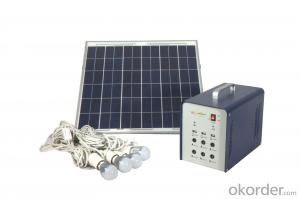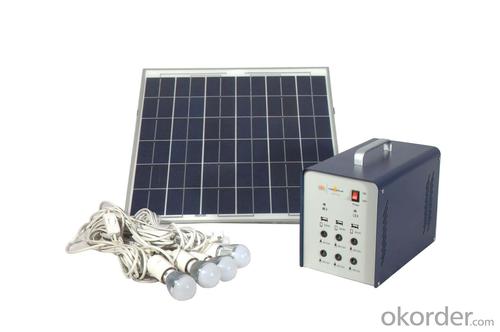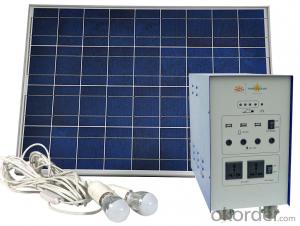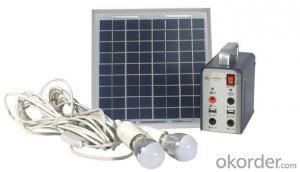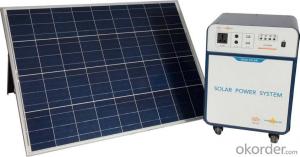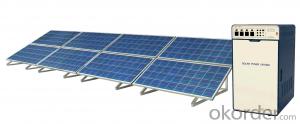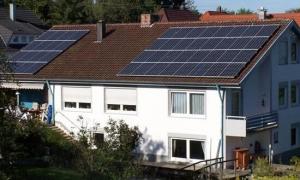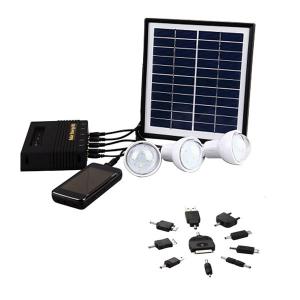Solar Energy Systems in Madurai - Home Off-Grid Solar Power System DC Lighting JS-SPS-200C
- Loading Port:
- Tianjin
- Payment Terms:
- TT OR LC
- Min Order Qty:
- 10 set
- Supply Capability:
- 10000 set/month
OKorder Service Pledge
Quality Product, Order Online Tracking, Timely Delivery
OKorder Financial Service
Credit Rating, Credit Services, Credit Purchasing
You Might Also Like
Off-grid Solar Power System
General Introduction
Solar power system provides alternating current and direct current, which is produced by the modules transforming solar power into power, to home lighting, household appliance and other DC appliance, such as cell phone and laptop.
Solar power system is widely used in area lack of power, for example house power supplying, monitoring, communication base, fire prevention in forest area, pasture and meadow, aquaculture etc.
We are dedicated to provide high quality off-grid PV products and systems to customers and has received a series of certificate, including ISO9001, TUV, UL, CE, CQC and RoHS.
Solar DC Lighting System
Multiple protection system, safe and reliable performance.
Integrated and portable design, easy operation.
DC5V, DC12V, AC220V output, wide range application.
Clean engergy, cycle use.
General Introduction
Solar power system provides alternating current and direct current, which is produced by the modules transforming solar power into power, to home lighting, household appliance and other DC appliance, such as cell phone and laptop.
Solar power system is widely used in area lack of power, for example house power supplying, monitoring, communication base, fire prevention in forest area, pasture and meadow, aquaculture etc.
We are dedicated to provide high quality off-grid PV products and systems to customers and has received a series of certificate, including ISO9001, TUV, UL, CE, CQC and RoHS.
Solar DC Lighting System
Multiple protection system, safe and reliable performance.
Integrated and portable design, easy operation.
DC5V, DC12V, AC220V output, wide range application.
Clean engergy, cycle use.

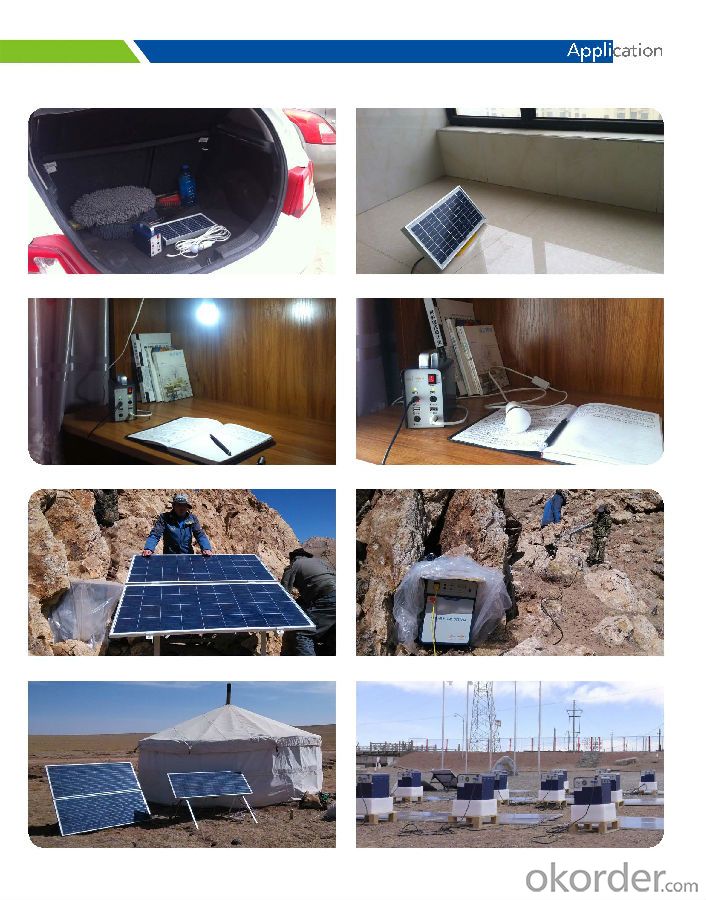

- Q: What are the environmental impacts of solar energy systems?
- Solar energy systems have minimal environmental impacts compared to other forms of energy generation. Some potential impacts include the production and disposal of solar panels, the use of land for solar installations, and the need for rare earth minerals in panel production. However, these impacts are relatively small and can be mitigated through proper recycling and responsible land use. Additionally, solar energy systems produce no greenhouse gas emissions during operation, helping to reduce air pollution and combat climate change. Overall, the environmental benefits of solar energy far outweigh its potential impacts.
- Q: Are there any noise concerns associated with solar energy systems?
- Noise concerns may arise when using solar energy systems, though they are generally quiet. One of the main sources of noise is the inverter, which converts DC electricity from the panels into AC electricity for use. The inverter may emit a low humming noise, similar to that of a fridge or AC unit. However, the noise level is typically very low and not considered disruptive. Fortunately, advancements in technology have led to the development of quieter inverters that produce minimal noise. Some inverters have noise reduction features like soundproof enclosures or low-noise fans. Additionally, the location of the inverter can help minimize noise concerns. Placing it in a well-insulated area, away from living spaces, can further reduce potential noise disturbances. It's important to note that other components of a solar energy system, such as mounting structures and wiring, do not generate significant noise. Solar panels themselves are noiseless as they rely on sunlight for electricity generation, without any moving parts. In conclusion, while certain components of solar energy systems may have noise concerns, advancements in technology and proper installation practices have greatly reduced potential disruptions.
- Q: Can solar energy systems be used in areas with high levels of wildlife activity?
- Yes, solar energy systems can be used in areas with high levels of wildlife activity. While it is true that wildlife can pose some challenges for solar energy systems, there are several ways to mitigate these issues. One of the primary concerns is the risk of damage to the solar panels by large animals or birds. However, there are various protective measures that can be taken to prevent this. For instance, installing fencing or barriers around the solar panels can help keep wildlife away. Additionally, using anti-reflective coatings on the panels can reduce the likelihood of bird collisions. Another concern is the impact of solar energy systems on wildlife habitats. It is crucial to choose the location of the solar panels carefully, considering the existing wildlife activity in the area. By conducting thorough environmental impact assessments and engaging with local wildlife experts, it is possible to minimize any potential negative effects on wildlife habitats. Moreover, solar energy systems can actually benefit wildlife in some cases. For example, solar farms can provide additional shelter and shade for some species, and the open spaces underneath the panels can create new habitats for ground-dwelling animals. Overall, while there may be some challenges, with proper planning and mitigation strategies, solar energy systems can be successfully utilized in areas with high levels of wildlife activity.
- Q: Can solar energy systems be used in powering research laboratories or scientific facilities?
- Yes, solar energy systems can certainly be used to power research laboratories or scientific facilities. Solar energy is a renewable and sustainable source of power that can be harnessed through the use of photovoltaic (PV) panels or solar thermal systems. Research laboratories and scientific facilities often require a significant amount of electricity to power various equipment such as microscopes, centrifuges, spectrometers, and other specialized scientific instruments. By installing solar panels on the rooftops or surrounding areas of these facilities, they can generate electricity from the sun's rays. The energy generated by solar panels can be used directly to power the laboratory's equipment, reducing their reliance on traditional fossil fuel-based electricity sources. Additionally, excess energy produced by the solar panels can be stored in batteries or fed back into the grid, ensuring a continuous and reliable power supply. There are several benefits to using solar energy in research laboratories and scientific facilities. Firstly, it helps reduce greenhouse gas emissions and mitigates the environmental impact of these facilities. Solar power is clean and does not produce any harmful pollutants, making it an environmentally friendly alternative to conventional electricity sources. Moreover, solar energy systems can provide a stable and cost-effective source of power in the long run. Although the initial installation costs may be higher, solar panels have a long lifespan and require minimal maintenance. This can lead to significant savings on electricity bills over time, allowing research laboratories and scientific facilities to allocate their resources towards other important research activities. Furthermore, solar energy systems can enhance the resilience and reliability of power supply to these facilities. In areas prone to power outages or with unreliable electricity grids, solar panels combined with battery storage can provide a backup power source, ensuring uninterrupted operation of critical scientific equipment. In conclusion, solar energy systems can indeed be used to power research laboratories and scientific facilities. They offer numerous environmental, economic, and operational advantages that make them a viable and sustainable choice for meeting the energy needs of these important scientific institutions.
- Q: What is the impact of temperature fluctuations on the performance of solar panels?
- Temperature fluctuations can have a significant impact on the performance of solar panels. High temperatures can cause a decrease in the efficiency of solar panels, leading to a decrease in power output. This is because increased temperatures can lead to an increase in the resistance of the materials used in the solar panels, resulting in more energy loss. On the other hand, low temperatures can improve the conductivity of the materials, leading to a slight increase in performance. However, extreme temperature fluctuations can also cause stress on the materials, potentially affecting the lifespan and durability of the solar panels. Overall, maintaining a moderate and stable temperature is crucial for optimizing the performance and longevity of solar panels.
- Q: Can solar energy systems be used in powering agricultural irrigation systems?
- Yes, solar energy systems can be used to power agricultural irrigation systems. Solar energy can be harnessed through photovoltaic panels or solar thermal systems to generate electricity or heat, respectively. This energy can then be utilized to power pumps, motors, and other components necessary for irrigation, reducing the reliance on grid electricity or diesel generators. Solar-powered irrigation systems are sustainable, cost-effective, and can be particularly beneficial in remote or off-grid agricultural areas.
- Q: Are there any government incentives or tax credits for installing a solar energy system?
- Yes, there are several government incentives and tax credits available for installing a solar energy system. These incentives and credits aim to promote the use of renewable energy sources and reduce dependence on fossil fuels. One of the most significant incentives is the federal Investment Tax Credit (ITC) which allows homeowners and businesses to deduct a portion of the cost of installing a solar energy system from their federal taxes. As of 2021, the ITC offers a 26% tax credit for residential and commercial solar installations. However, it is important to note that the percentage may change in the following years, so it is advisable to take advantage of the current rate. Additionally, some states and local governments offer their own incentives and tax credits for solar installations. These incentives can vary widely, but they often include rebates, grants, or property tax exemptions for homeowners and businesses that adopt solar energy systems. Furthermore, there are also net metering programs in many states that allow solar system owners to receive credits on their utility bills for any excess electricity they generate and feed back into the grid. This allows solar energy system owners to offset their electricity costs and potentially earn money by selling surplus energy. In conclusion, there are numerous government incentives and tax credits available for installing a solar energy system. These incentives aim to make solar installations more affordable and encourage the transition to clean, renewable energy sources. It is advisable to consult with local authorities, utility companies, and tax professionals to fully understand and take advantage of the incentives and credits available in your area.
- Q: Can solar energy systems be used for powering electric bike charging stations?
- Yes, solar energy systems can be used to power electric bike charging stations. Solar panels can generate electricity from sunlight, which can then be used to charge electric bikes. This renewable and sustainable energy source is a great option for powering charging stations, reducing reliance on traditional energy sources and promoting eco-friendly transportation.
- Q: What is the role of inverters in solar energy systems?
- The role of inverters in solar energy systems is to convert the direct current (DC) electricity generated by solar panels into alternating current (AC) electricity that can be used to power homes, businesses, and the electrical grid. Inverters also help optimize the performance of solar energy systems by monitoring and regulating the flow of electricity, ensuring maximum efficiency and compatibility with the existing electrical infrastructure.
- Q: Can a solar energy system be installed on a mobile home?
- Yes, a solar energy system can be installed on a mobile home. In fact, mobile homes are well-suited for solar installations due to their relatively small energy requirements and often ample roof space. Solar panels can be mounted on the roof or on the ground near the mobile home, depending on the available space and orientation to the sun. The size of the solar system will depend on the energy needs of the mobile home, which can be determined by analyzing the household's electricity consumption. With the proper design and installation, a solar energy system can provide clean, renewable energy to power the mobile home's electrical needs, reducing reliance on traditional energy sources and potentially lowering electricity bills.
Send your message to us
Solar Energy Systems in Madurai - Home Off-Grid Solar Power System DC Lighting JS-SPS-200C
- Loading Port:
- Tianjin
- Payment Terms:
- TT OR LC
- Min Order Qty:
- 10 set
- Supply Capability:
- 10000 set/month
OKorder Service Pledge
Quality Product, Order Online Tracking, Timely Delivery
OKorder Financial Service
Credit Rating, Credit Services, Credit Purchasing
Similar products
Hot products
Hot Searches
Related keywords
